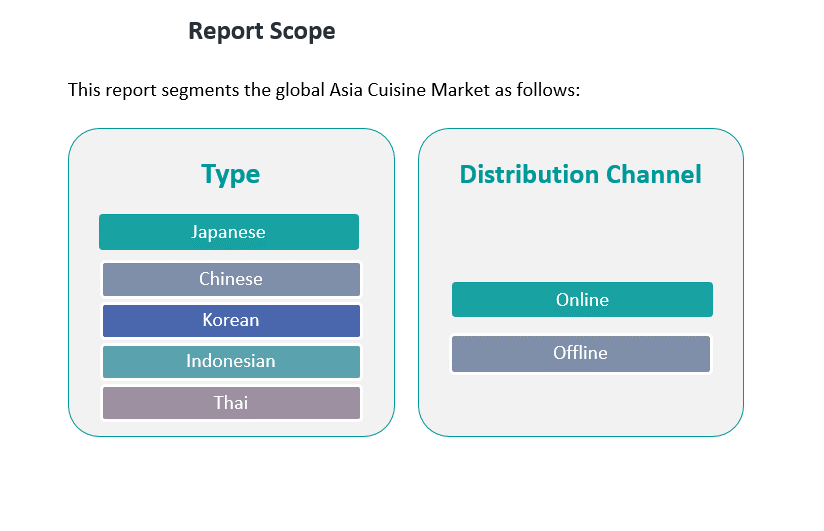CHAPTER NO. 1 : INTRODUCTION 16
1.1.1. Report Description 16
Purpose of the Report 16
USP & Key Offerings 16
1.1.2. Key Benefits for Stakeholders 16
1.1.3. Target Audience 17
1.1.4. Report Scope 17
CHAPTER NO. 2 : EXECUTIVE SUMMARY 18
2.1. Asia Cuisine Market Snapshot 18
2.1.1. U.S. Asia Cuisine Market, 2018 – 2032 (USD Million) 19
CHAPTER NO. 3 : ASIA CUISINE MARKET – INDUSTRY ANALYSIS 20
3.1. Introduction 20
3.2. Market Drivers 21
3.2.1. Growing Popularity of Asian Cuisine 21
3.2.2. Increasing Availability 22
3.2.3. Health and Wellness Trends 23
3.3. Market Restraints 24
3.3.1. Supply Chain Challenges 24
3.3.2. Cultural Barriers 24
3.4. Market Opportunities 25
3.4.1. Market Opportunity Analysis 25
3.5. Porter’s Five Forces Analysis 26
CHAPTER NO. 4 : ANALYSIS COMPETITIVE LANDSCAPE 27
4.1. Company Market Share Analysis – 2023 27
4.1.1. U.S. Asia Cuisine Market: Company Market Share, by Volume, 2023 27
4.1.2. U.S. Asia Cuisine Market: Company Market Share, by Revenue, 2023 28
4.1.3. U.S. Asia Cuisine Market: Top 6 Company Market Share, by Revenue, 2023 28
4.1.4. U.S. Asia Cuisine Market: Top 3 Company Market Share, by Revenue, 2023 29
4.2. U.S. Asia Cuisine Market Company Revenue Market Share, 2023 30
4.3. Company Assessment Metrics, 2023 31
4.3.1. Stars 31
4.3.2. Emerging Leaders 31
4.3.3. Pervasive Players 31
4.3.4. Participants 31
4.4. Start-ups /SMEs Assessment Metrics, 2023 31
4.4.1. Progressive Companies 31
4.4.2. Responsive Companies 31
4.4.3. Dynamic Companies 31
4.4.4. Starting Blocks 31
4.5. Strategic Developments 32
4.5.1. Acquisitions & Mergers 32
New Product Launch 32
U.S. Expansion 32
4.6. Key Players Product Matrix 33
CHAPTER NO. 5 : PESTEL & ADJACENT MARKET ANALYSIS 34
5.1. PESTEL 34
5.1.1. Political Factors 34
5.1.2. Economic Factors 34
5.1.3. Social Factors 34
5.1.4. Technological Factors 34
5.1.5. Environmental Factors 34
5.1.6. Legal Factors 34
5.2. Adjacent Market Analysis 34
CHAPTER NO. 6 : ASIA CUISINE MARKET – BY TYPE SEGMENT ANALYSIS 35
6.1. Asia Cuisine Market Overview, by Type Segment 35
6.1.1. Asia Cuisine Market Revenue Share, By Type, 2023 & 2032 36
6.1.2. Asia Cuisine Market Attractiveness Analysis, By Type 37
6.1.3. Incremental Revenue Growth Opportunity, by Type, 2024 – 2032 37
6.1.4. Asia Cuisine Market Revenue, By Type, 2018, 2023, 2027 & 2032 38
6.2. Japanese 39
6.3. Chinese 40
6.4. Korean 41
6.5. Indonesian 42
6.6. Others 43
CHAPTER NO. 7 : ASIA CUISINE MARKET – BY DISTRIBUTION CHANNEL SEGMENT ANALYSIS 44
7.1. Asia Cuisine Market Overview, by Distribution Channel Segment 44
7.1.1. Asia Cuisine Market Revenue Share, By Distribution Channel, 2023 & 2032 45
7.1.2. Asia Cuisine Market Attractiveness Analysis, By Distribution Channel 46
7.1.3. Incremental Revenue Growth Opportunity, by Distribution Channel, 2024 – 2032 46
7.1.4. Asia Cuisine Market Revenue, By Distribution Channel, 2018, 2023, 2027 & 2032 47
7.2. Online 48
7.3. Offline 49
CHAPTER NO. 8 : ASIA CUISINE MARKET – NORTH AMERICA 50
8.1.1. U.S. Asia Cuisine Market Revenue, By Type, 2018 – 2023 (USD Million) 50
8.1.2. U.S. Asia Cuisine Market Revenue, By Distribution Channel, 2018 – 2023 (USD Million) 51
CHAPTER NO. 9 : COMPANY PROFILES 52
9.1. Panda Express 52
9.1.1. Company Overview 52
9.1.2. Product Portfolio 52
9.1.3. Swot Analysis 52
9.1.4. Business Strategy 53
9.1.5. Financial Overview 53
9.2. Chipotle 54
9.3. Wagamama 54
9.4. Noodles & Company 54
9.5. Kogi BBQ 54
9.6. Shake Shack 54
9.7. The Cheesecake Factory 54
9.8. Nestlé 54
9.9. Conagra Brands: 54
9.10. Mc Cormick & Company Inc. 54
9.11. JFC 54
List of Figures
FIG NO. 1. U.S. Asia Cuisine Market Revenue, 2018 – 2032 (USD Million) 20
FIG NO. 2. Porter’s Five Forces Analysis for U.S. Asia Cuisine Market 27
FIG NO. 3. Company Share Analysis, 2023 28
FIG NO. 4. Company Share Analysis, 2023 29
FIG NO. 5. Company Share Analysis, 2023 29
FIG NO. 6. Company Share Analysis, 2023 30
FIG NO. 7. Asia Cuisine Market – Company Revenue Market Share, 2023 31
FIG NO. 8. Asia Cuisine Market Revenue Share, By Type, 2023 & 2032 37
FIG NO. 9. Market Attractiveness Analysis, By Type 38
FIG NO. 10. Incremental Revenue Growth Opportunity by Type, 2024 – 2032 38
FIG NO. 11. Asia Cuisine Market Revenue, By Type, 2018, 2023, 2027 & 2032 39
FIG NO. 12. U.S. Asia Cuisine Market for Japanese, Revenue (USD Million) 2018 – 2032 40
FIG NO. 13. U.S. Asia Cuisine Market for Chinese, Revenue (USD Million) 2018 – 2032 41
FIG NO. 14. U.S. Asia Cuisine Market for Korean, Revenue (USD Million) 2018 – 2032 42
FIG NO. 15. U.S. Asia Cuisine Market for Indonesian, Revenue (USD Million) 2018 – 2032 43
FIG NO. 16. U.S. Asia Cuisine Market for Others, Revenue (USD Million) 2018 – 2032 44
FIG NO. 17. Asia Cuisine Market Revenue Share, By Distribution Channel, 2023 & 2032 46
FIG NO. 18. Market Attractiveness Analysis, By Distribution Channel 47
FIG NO. 19. Incremental Revenue Growth Opportunity by Distribution Channel, 2024 – 2032 47
FIG NO. 20. Asia Cuisine Market Revenue, By Distribution Channel, 2018, 2023, 2027 & 2032 48
FIG NO. 21. U.S. Asia Cuisine Market for Online, Revenue (USD Million) 2018 – 2032 49
FIG NO. 22. U.S. Asia Cuisine Market for Offline, Revenue (USD Million) 2018 – 2032 50
List of Tables
TABLE NO. 1. : U.S. Asia Cuisine Market: Snapshot 19
TABLE NO. 2. : Drivers for the Asia Cuisine Market: Impact Analysis 22
TABLE NO. 3. : Restraints for the Asia Cuisine Market: Impact Analysis 25
TABLE NO. 4. : U.S. Asia Cuisine Market Revenue, By Type, 2018 – 2023 (USD Million) 51
TABLE NO. 5. : U.S. Asia Cuisine Market Revenue, By Type, 2024 – 2032 (USD Million) 51
TABLE NO. 6. : U.S. Asia Cuisine Market Revenue, By Distribution Channel, 2018 – 2023 (USD Million) 52
TABLE NO. 7. : U.S. Asia Cuisine Market Revenue, By Distribution Channel, 2024 – 2032 (USD Million) 52




